Managed WordPress hosting has exploded in the past couple of years, but the concept of hosting specifically optimized for running WordPress sites was pioneered by just a few companies.
Pagely was one of those forerunners back in 2006 as the first ever managed WordPress platform, and in this article, we're going to take a look at what they have to offer and what still sets them apart from other managed WordPress hosting solutions nearly a decade later.
Features
Most managed WordPress hosts all have a few things in common.
- Innovative ways to optimize WordPress to really make it sing.
- Conveniences like automatic WordPress core updates, plugin updates, backups, speed optimization, etc., which give you peace of mind and maybe even some money back in your pocket by being able to cancel other services that help do some of these things.
- Quick and knowledgable support.
However, there are a few things that Pagely does in their managed WordPress hosting that sets them apart from others.
Instant Scalability
Pagely uses Amazon Web Services for the foundation of their infrastructure. There are some very key benefits Pagely can offer by doing this.
- Nearly infinite flexibility and scalability with optimized EC2 instances that can scale to accommodate the most demanding WordPress application's.
- Their network edge that features a globally distributed caching system that serves billions of requests weekly.
Increased Security
Pagely developed what they call PressARMOR to specifically address weaknesses and security concerns around WordPress. While nothing is 100% hack-proof, they have made it their mission to be the most secure WordPress web host around.
Integrated CDN
Lots of managed WordPress site comes with CDN integration, usually as an upsell and usually as a tie in to a third party service. This isn't a bad thing, but Pagely takes CDN integration to the next level.
Not only did they develop PressCDN, which is also offered as its own service, but they include it as a part of all the plans they offer. PressCDN is incredibly easy to use and fully integrated into your Pagely account. Just flip the switch on and enjoy some of the fastest content your site has ever served.
Plans
Pagely has a wide range of plans to choose from. There is literally something for everyone. There are three tiers of plans, ranging from a single site to completely custom tailored solutions for the largest of demanding enterprise companies.
- The Personal / Business plans range from a single site up to 20 sites, with various limits on disk space, bandwidth, and CDN usage.
- The VPS plans range from 35 sites to 50 sites, with various limits on disk space, bandwidth, and CDN usage. These plans also include extra goodies like full SSH access and Git / SVN deployment.
- The Enterprise plans offer the highest performance and almost unfathomable scalability for even the largest of sites. These plans offer dedicated and direct support to account managers and system engineers, complete customization of nodes and distributed load balancing, and greater control over CDN and security.
Pagely even offers a nice side-by-side comparison of all their plans, so you can see how they stack up against each other.
We tested their Business plan, which would most likely be a plan many of you would find yourselves evaluating. It comes with the ability to manage up to three WordPress sites for a total of 10 GB of disk space, 10 GB of bandwidth, and 50 GB of CDN bandwidth.
Getting The Keys
Sign up is a breeze, and with that out of the way, Pagely kicks in to full gear to get you up and running. Since we picked a Personal / Business plan, our space was available immediately. VPS and Enterprise plans can take a couple of days to procure.
First is an email confirming your subscription, with renewal information outlined so you know when you're on the hook for next months bill. Always good to know.
Next up are the keys to the administration to all your managed sites, called Atomic Core. More on that, in great detail, in a bit.
Then, if you indicated a domain you wanted to get started with, you'll receive credentials for the WordPress admin for the site and SFTP access. If you didn't, the spinning up a new site literally takes less then a minute to install in their infrastructure. It could not be more easy.
A bunch of emails - who cares, right?
What I was super impressed with are the generated passwords. All completely unique, lengthy (ranging from 15 - 40 characters), and random. Normally I have to do this all myself and then tuck them away with 1Password, but there was no need here, which is a pleasant surprise. In a world where major companies seem to get compromised on a monthly basis, this feels like an extra level of care to protect you in the event something would ever go wrong.
The Managed Hosting Experience, The Pagely Way
Finally, the main event! Let's take a look around and see what the Pagely managed hosting experience has to offer.
Atomic Core
As previously mentioned, Atomic Core is your command center for all of your managed WordPress sites and services.
The first impressions are quite lovely. Very clean, fresh, informative, and breeze to use. This is nothing like some of the cluttered and unflattering control panels I've seen.
Dashboard
The dashboard view gives you a nice overview of how you're using your plan, with quick views and links to the sites you have running and how you are utilizing your plan's allotted resources.

Sites
The sites view give you a detailed breakdown of each site's resources. This is helpful for determining if you have one site in particular that is starting to become the dominating consumer of your plan's allocations.

From there, you can dive into what is called the app details view for each site. In here you can manage all the specifics for your site.
Aliases for how visitors can access your site, including redirects.
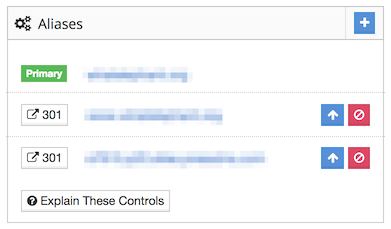
DNS information, which is super helpful and informative for when you are first getting your site wired up correctly to Pagely's servers.

Access to this sites backups, with downloads for both your database and your site files. You can say goodbye to other backup accounts, if you have any, and hello to some monthly savings!

And finally, there are some helpful utilities, or what they call "common actions", for things like resetting your SFTP account and purging your site and CDN cache.
But also baked in there is something called "whitescreen eliminator" to help you get back into your site when a theme or plugin change has gone awry and your left with a blank white screen and no way to get back into your site.
After leading a WordPress support forum for 3.5 years for a leading theme development shop, I cannot even begin tell you how many times something like this would have been so helpful on a customers behalf. Something so simple, yet so incredibly helpful for when things go awry and you are locked out of your site. I could hug someone at Pagely right now.
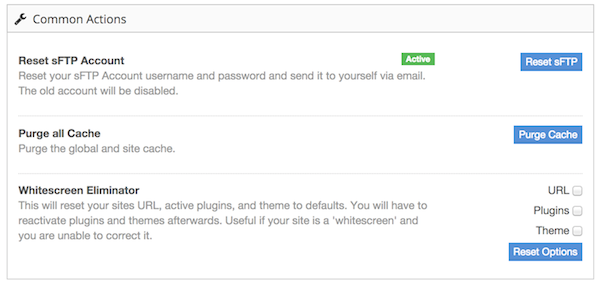
Sub Accounts
Sub accounts is a new feature that was just added at the beginning of October. It's a simple way to grant trusted users access to Atomic Core, but as Pagely says, use good judgement.
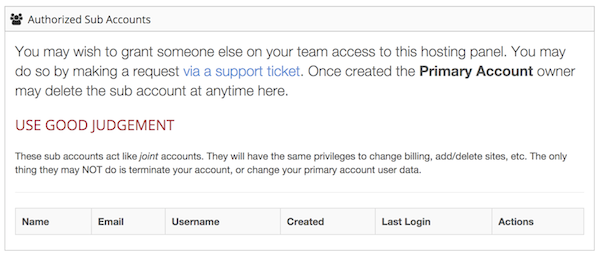
Referrals
Pagely does offer an attractive affiliate program, ranging from a $99 commission on a personal plan to $500 for a referral on a VPS plan.
There's a nice space in Atomic Core for you to track where all those referrals are coming from.
Support
The baked in support of Atomic Core is pretty lean. It consists of:
- A brief FAQ.
- Some very basic "how to" WordPress videos, mostly centered around how to use the WordPress admin.
- Quick links to launch into recent support tickets and open a new support ticket
- A list of banned plugins, which are mostly plugins that contain duplicate functionality Pagely already handles, like backups, caching, scanners / checkers, etc.
The real bulk of the support system is handled by Pagely's external support system, which is hosted on a very customized Zendesk installation. Which, there's nothing wrong with that. Zendesk is a very solid and popular choice for support by many in the WordPress community.
SFTP
What can really be said about SFTP? It's pretty much the way websites have been manage and deployed for years.
However, there was one peculator oddity that I have never seen before: All of the core WordPress files are symbolic links.
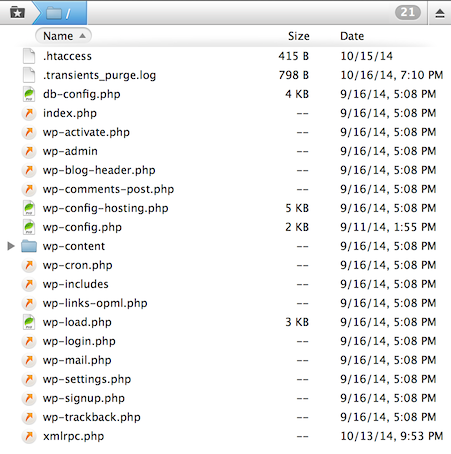
You cannot modify, duplicate, or download the symlinks. Apparently the only thing you can do is delete them, which I did because why not? It was in the name of research!
Kristopher LaGraff from Pagely support was kind enough to put the deleted symlink back for me and provided a explanation as to why all the core WordPress files are symlinks.
We do not do this in attempt to limit user's capabilities, but to stand by the fact that it's really bad practice to hack core. As I'm sure you're aware, a lot of new users attempt to modify core as opposed to writing custom functions or plugins.
This is an incredibly clever idea.
I should also note that I submitted the support ticket to replace the deleted file at 9:49pm CST. Within 10 minutes, the file was restored. That is impressive turn around time for that time of night!
WordPress Admin
Some managed WordPress hosts will add their own, custom, top level WordPress admin menu to help you administer your WordPress installation. Pagely adds one too, but it looks like it's on the decline. Everything seems to have been replaced with Atomic Core.
Pagely does preinstall, preconfigure, and activate Akismit and W3 Total Cache with every new WordPress installation. When asked if they were required and / or could be uninstalled or swapped out for other comparable plugging, this was Pagely's reply:
We do install both plugins by default. I recommend keeping Akismet installed for handling spam comments, although W3TC is your call. We install W3TC for clients that have a third-party CDN and need to integrate it into our stack, but if you aren't using it for CDN connection, then we will handle your cache and CDN. But yes, you can uninstall both if you prefer.
How Does Pagely Compare?
There are two critical website metrics I am always interesting in monitoring when trying out any new hosting service:
- The speed and performance of the server, so content can be delivered as quick as possible to visitors.
- The uptime and availability of the website because what's the point if visitors cannot get to the site.
Speed
To accurately quantify the speed metrics, we setup the following test case to compare Pagely to a reputable shared hosting provider.
- Both sites running WordPress 4.0.
- Both sites using the TwentyThirteen theme.
- Both sites had the same plugins activated, with the exception of W3 Total Cache only installed on the Pagely site and wired up to Pagely's built-in CDN, PressCDN.
- Both sites imported the same post, media, and comments, which was a recipe from a client's cooking blog, so it has lots of pictures and instructions for making the recipe.
All in all, the test scenario added up to around 50 - 63 requests and a 2.1 MB page size.
We then used WBench to compare the two hosts. There are services like Pingdom and GTmetrix which also run speed tests, but what sets WBench apart is that it runs on your computer using your bandwidth. It's more like what your real visitors will be using and experiencing and not some supped up server with a mega fiber connection.
WBench works like this.
- It simulates users visiting your website for the first time, with nothing of your site cached. Yes, that means W3 Total Cache will factor less in the measurements and really just focus on the speed of the sever and the CDN, which means the site will load even faster once W3 Total Cache is able to do it's job.
- It will load the site in the browser 10 times, tracking metrics for each page load.
- Produce a report which outlines the fastest, median (not average), slowest, and standard deviation across the 10 tests.
Below are the results of the test.
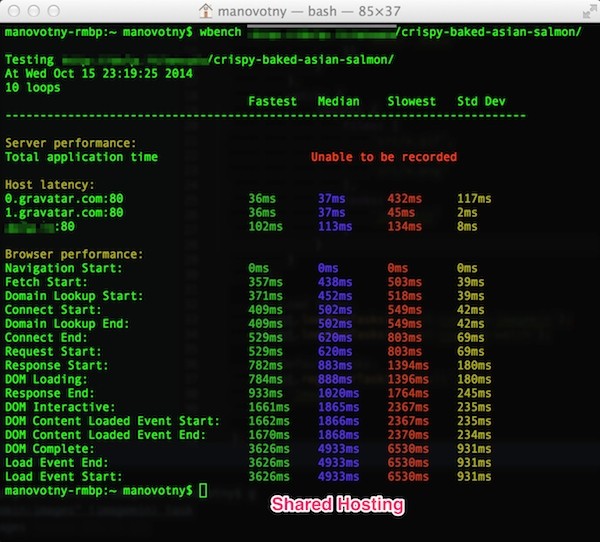
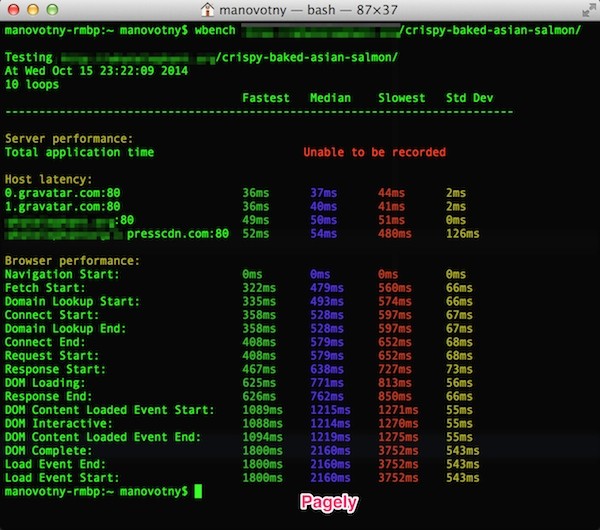
Both through WBench and manually monitoring the page load times via Chrome Developer Tools, Pagely is consistently twice as fast as a reputable shared hosting provider.
That is nothing to be upset about!
Uptime
From the moment we got access to our account, we added a monitor for uptime via UptimeRobot to track the site's availability.
For the month we've been testing Pagely, there have been zero outages with 100% uptime. Granted, that's not a large window for monitoring, and it would have to be very unfortunate timing, but we wanted to track and report on it nonetheless.
Is Managed WordPress Hosting Worth The Premium Price?
I have worked with more hosts than I can remember, but have learned one lesson through them all. Not all hosting is created equal. If you value your time, managed hosting is most certainly worth every bit more.
For both myself, and the clients I work with, the extra price is well worth the time we save and the stress we no longer have. As a developer, I don’t have to worry about what I don’t know or what I’ll have to become an expert on, especially with things I really don’t want to be an expert on, like database connection errors. And if you have clients, they don’t have to worry how their site is performing, how it is impacting their readers, hampering their ability to compose posts, or feel like they are constantly bothering me.
That freedom is life changing, freeing up your time to write more posts or develop more themes and plugins.
Everything comes with a 30 day, risk-free trial, so there's really no reason at all to give Pagely a shot to see how it compares to what you already have.


Comments